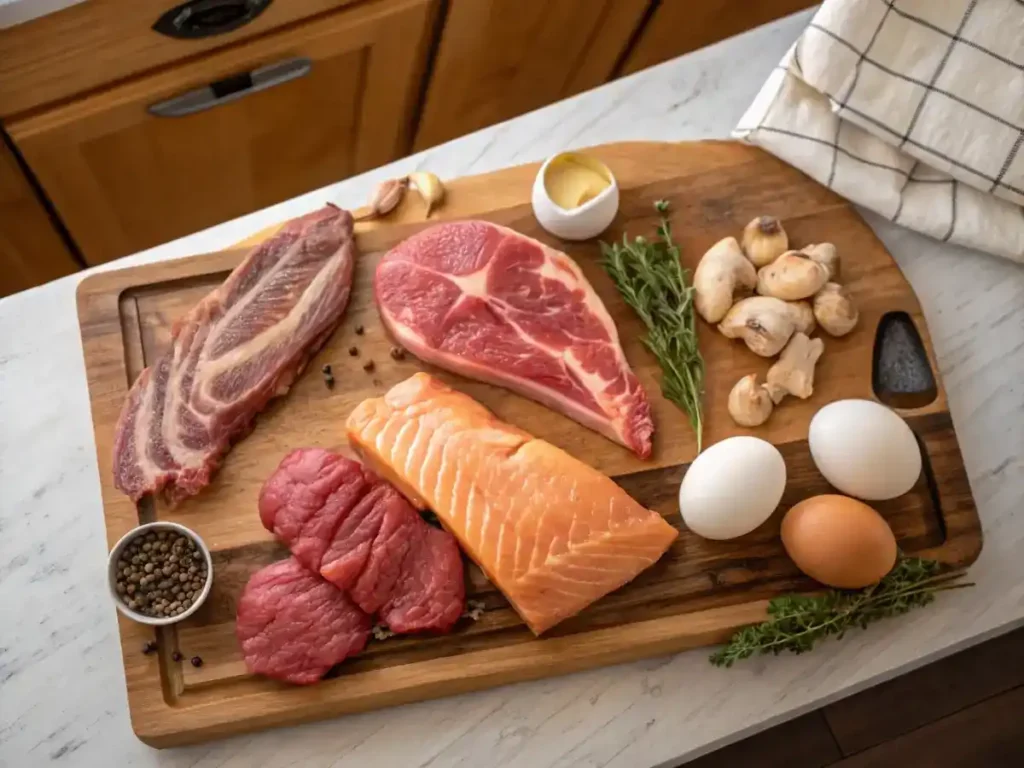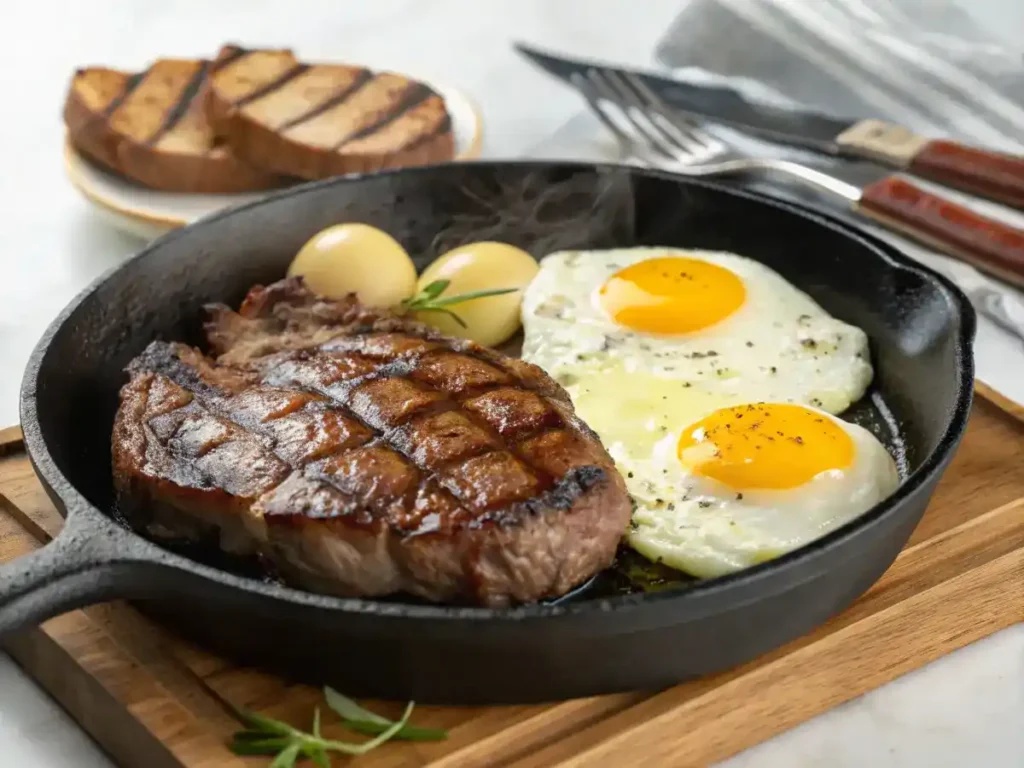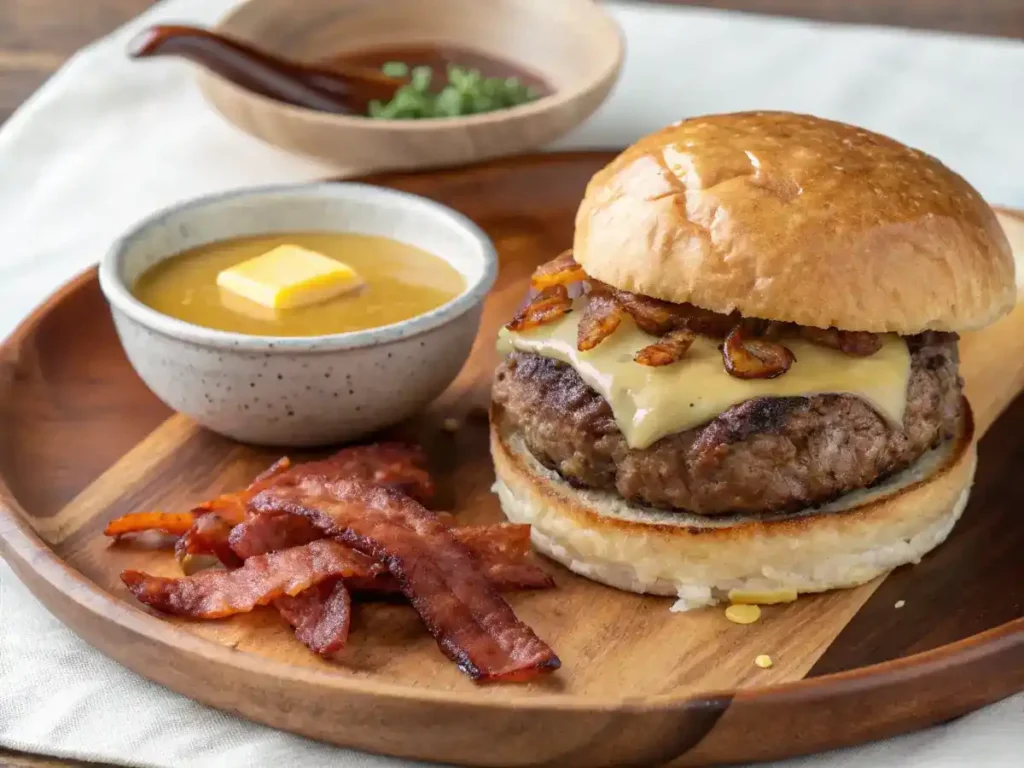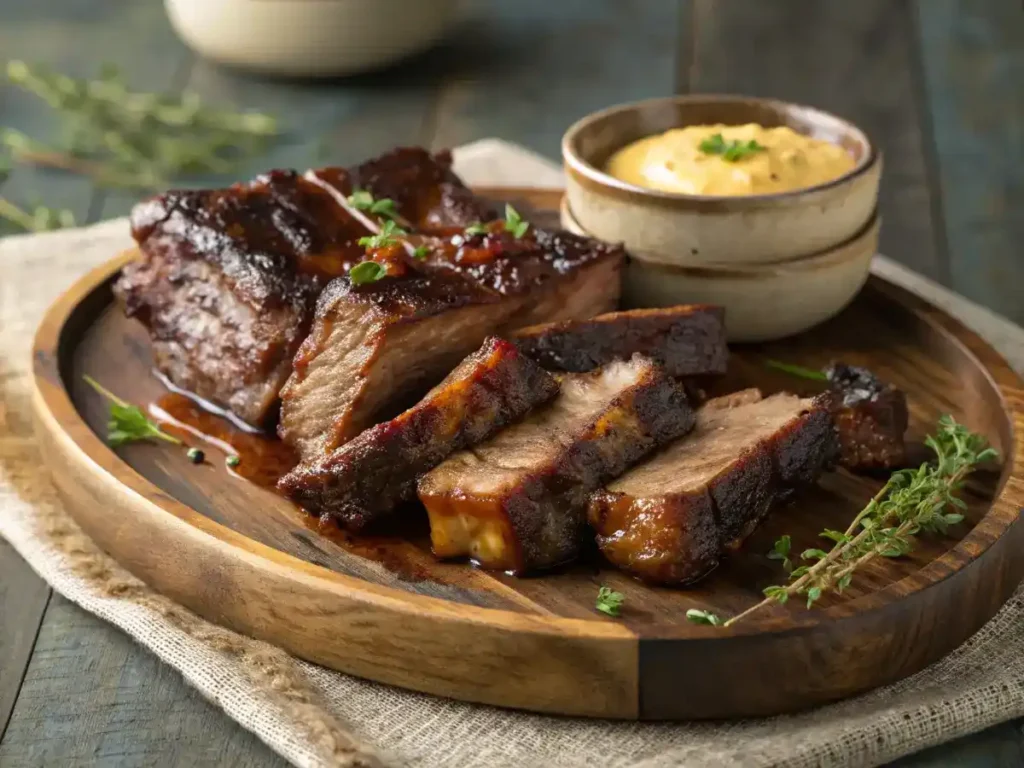The carnivore diet is gaining popularity, and having a variety of carnivore diet recipes ensures success. These high-protein, meat-based meals are perfect for anyone following a strict carnivore meal plan. Advocates praise its potential benefits, including weight loss, enhanced mental clarity, and improved overall health. However, a common challenge for many is maintaining variety and excitement in their meals. Relying solely on meat and animal-derived products can seem monotonous, but with a bit of creativity, it’s possible to craft a diverse and satisfying meal plan. This guide aims to provide a comprehensive collection of delicious and nutritious carnivore diet recipes, ensuring that your journey remains both enjoyable and healthful.
Table of Contents
Understanding the Carnivore Diet
The carnivore diet is a nutritional approach that involves consuming only animal-based foods, completely eliminating plant-derived items. This means a diet rich in meats, fish, eggs, and certain dairy products, while excluding vegetables, fruits, grains, legumes, nuts, and seeds. Proponents of this diet argue that human beings thrived on animal-based diets for millennia and that returning to such eating patterns can offer various health benefits.
For those looking to explore different ways of preparing chicken while staying true to the carnivore diet, check out this guide on spatchcock chicken for a flavorful and efficient cooking method.
What is the Carnivore Diet?
At its core, the carnivore diet is straightforward: if it comes from an animal, it’s on the menu; if not, it’s excluded. This includes:
- Meat: Beef, lamb, poultry, and other meats.
- Fish and Seafood: Salmon, sardines, shrimp, etc.
- Animal Fats: Butter, tallow, lard.
- Dairy: Cheese, cream, and yogurt (for those who tolerate dairy).
- Eggs: All varieties.
This diet is often seen as an extension of low-carb and ketogenic diets, pushing carbohydrate restriction to its limit by excluding all plant-based foods. The primary energy sources become fats and proteins, leading the body into a state of ketosis, where it burns fat for fuel.
Benefits of the Carnivore Diet
Advocates of the carnivore diet report several potential health benefits:
- Weight Loss: Many individuals experience weight loss due to reduced calorie intake and the satiating nature of protein-rich foods.
- Improved Mental Clarity: Some followers report enhanced focus and cognitive function, possibly due to stabilized blood sugar levels.
- Reduced Inflammation: Eliminating plant-based foods can lead to a decrease in certain inflammatory markers, benefiting those with autoimmune conditions.
- Simplified Eating: With fewer food choices, meal planning becomes straightforward, reducing decision fatigue.
It’s important to note that while anecdotal evidence is abundant, scientific research on the long-term effects of the carnivore diet is limited. Individuals interested in this diet should consult with healthcare professionals before making significant dietary changes.
Common Misconceptions and Challenges
Despite its simplicity, the carnivore diet is surrounded by misconceptions:
- Nutrient Deficiencies: Critics argue that excluding plant foods can lead to deficiencies in vitamins C and K, fiber, and antioxidants. However, proponents claim that animal organs and certain cuts of meat provide adequate nutrients.
- Cholesterol and Heart Disease: There’s a concern that a high intake of saturated fats may increase cholesterol levels. Yet, some studies suggest that dietary cholesterol does not significantly impact blood cholesterol in most people.
- Digestive Issues: Transitioning to an all-meat diet can lead to digestive changes, such as constipation or diarrhea. It’s essential to stay hydrated and consider electrolyte balance during the adaptation phase.
Challenges include social situations where dietary options are limited, potential monotony in meal choices, and the need for careful sourcing of quality animal products to ensure optimal health.
Essential Ingredients for Carnivore Recipes

The carnivore diet may seem restrictive at first, but it offers a surprising variety of ingredients that provide flavor, nutrition, and satiety. Choosing the right foods ensures that meals remain enjoyable while supporting overall health. Here’s a breakdown of essential ingredients for carnivore-friendly cooking.
Best Protein Sources for Carnivore Diet Recipes
Animal-based proteins form the foundation of the carnivore diet. Choosing high-quality cuts of meat ensures optimal nutrition and flavor.
- Beef – One of the most nutrient-dense proteins, beef provides high-quality protein, essential fatty acids, and key nutrients like iron and B vitamins. Popular choices include ribeye, sirloin, ground beef, and brisket. Grass-fed beef is often preferred for its higher omega-3 content and superior nutrient profile.
- Poultry – Chicken and turkey are excellent lean protein sources that add variety to carnivore meals. Dark meat, such as thighs and drumsticks, contains more fat, making it ideal for maintaining satiety. Bone-in cuts and skin-on options provide additional nutrients and flavor.
- Fish and Seafood – Fatty fish like salmon, sardines, and mackerel are rich in omega-3 fatty acids, which support heart and brain health. Shellfish such as shrimp, mussels, and scallops provide protein along with minerals like zinc and selenium.
- Organ Meats – Liver, heart, kidneys, and other organ meats are some of the most nutrient-dense foods available. Liver, for example, is packed with vitamin A, iron, and other essential nutrients. While not everyone enjoys the taste, incorporating small amounts into ground meats or stews can help boost nutrition without overpowering the dish.
Healthy Fats and Dairy for Carnivore Diet Recipes
Since the carnivore diet eliminates carbohydrates, fats play a crucial role in energy production and meal satisfaction.
- Animal Fats – Healthy fats from animals, such as beef tallow, lamb fat, and duck fat, provide energy and enhance the flavor of meals. Cooking with animal fats instead of vegetable oils ensures a fully carnivore-friendly approach.
- Dairy Products – Some carnivore diet variations allow for dairy consumption. Cheese, butter, and heavy cream provide additional fat and protein, though some individuals may need to avoid dairy if they experience intolerance. Opting for full-fat, unprocessed dairy products helps maintain purity and nutritional benefits.
Flavor Enhancements for Carnivore Diet Recipes
While traditional seasoning options are limited, a few simple additions can enhance the taste of carnivore meals without straying from the diet’s principles.
- Herbs and Spices – Many people following a strict carnivore diet avoid plant-based seasonings altogether. However, salt, black pepper, and minimal-use spices such as garlic powder and paprika can add depth to meats. Quality sea salt or Himalayan salt helps maintain electrolyte balance, which is crucial for overall well-being.
- Broths and Stocks – Homemade bone broth is an excellent source of collagen, gelatin, and minerals that support gut health and joint function. Simmering beef or chicken bones for several hours extracts essential nutrients and creates a rich, flavorful liquid that can be consumed on its own or used as a base for carnivore-friendly soups and stews.
By focusing on high-quality meats, beneficial fats, and minimal seasoning, it’s easy to create satisfying and nutrient-rich meals within the carnivore diet framework.
Best Carnivore Diet Recipes for Breakfast

Starting the day with a high-protein, nutrient-rich meal is essential for sustained energy and satiety. Carnivore diet recipes for breakfast focus on simple yet delicious ingredients like eggs, meats, and healthy fats. Here are some satisfying breakfast ideas.
Classic Steak and Eggs for the Carnivore Diet
A staple of carnivore diet recipes, steak and eggs provide a protein-packed start to the day. This meal is rich in amino acids, healthy fats, and essential vitamins.
How to Make It:
- Choose a high-fat cut like ribeye or New York strip for added flavor.
- Cook the steak to your preferred doneness using butter or beef tallow.
- Fry eggs in the same pan to absorb the steak’s flavors.
- Season with salt and serve hot.
Why It Works:
- High in protein for muscle maintenance.
- Keeps you full for hours.
- Simple and quick to prepare.
Carnivore Omelette with Beef and Cheese
Omelettes are an easy way to include a variety of proteins in one meal. This carnivore-friendly omelette eliminates vegetables and focuses on meat, eggs, and dairy.
How to Make It:
- Beat 3-4 eggs and mix with shredded cheese.
- Cook ground beef or sliced steak in a pan with butter.
- Pour the eggs over the cooked meat and let it set.
- Fold and serve with an extra sprinkle of cheese.
Why It Works:
- Combines protein and fat for sustained energy.
- Easy to customize with different meats.
- Quick to prepare for busy mornings.
Bone Broth Breakfast Bowl for Carnivore Diet
Bone broth is a nutrient-dense, gut-healing option for those following carnivore diet recipes. This breakfast is warm, nourishing, and packed with collagen and minerals.
How to Make It:
- Simmer beef or chicken bones for 12-24 hours to extract nutrients.
- Strain the broth and store it for daily use.
- Heat a cup of broth in the morning and sip it warm.
- Optionally, add egg yolks or shredded meat for extra protein.
Why It Works:
- Supports gut and joint health.
- Hydrating and easy to digest.
- Provides essential minerals like calcium and magnesium.
By incorporating these carnivore diet breakfast recipes, you can enjoy a variety of protein-rich meals to fuel your day.
Lunch Recipes for the Carnivore Diet

Midday meals on the carnivore diet should be satisfying, and with the right carnivore diet recipes, you can enjoy simple and delicious options.. Whether you’re at home or on the go, these carnivore diet lunch recipes offer a mix of high-quality protein and healthy fats to keep you fueled.
Grilled Liver and Onions for the Carnivore Diet
Organ meats, especially liver, are among the most nutrient-dense foods available. This carnivore diet recipe provides a powerful dose of iron, vitamin A, and B vitamins.
How to Make It:
- Slice beef or chicken liver into thin strips.
- Melt butter or tallow in a pan and sear the liver for 2-3 minutes per side.
- For added flavor, lightly sauté thinly sliced onions (if tolerated) in the same pan.
- Season with salt and serve hot.
Why It Works:
- Provides essential vitamins and minerals.
- Quick and easy to cook.
- Great for supporting energy and overall health.
Carnivore Burger with Cheese and Butter
A burger without the bun? Absolutely! This carnivore diet burger recipe is packed with protein and healthy fats for a filling and delicious meal.
How to Make It:
- Form ground beef into thick patties (80/20 beef is ideal for fat content).
- Grill or pan-fry in butter or tallow until desired doneness.
- Top with melted cheese and a slice of butter for extra richness.
- Serve with a side of crispy beef bacon or an egg for variety.
Why It Works:
- High in protein and fat for sustained energy.
- Easy to meal prep in bulk.
- Simple, yet incredibly flavorful.
Seafood Medley for Carnivore Diet Lunches
Adding seafood to your carnivore diet recipes brings variety and important nutrients like omega-3s. This dish is perfect for those who want a break from red meat while staying fully carnivore.
How to Make It:
- Select a mix of shrimp, salmon, and scallops.
- Sear in a hot pan with butter or ghee until golden brown.
- Sprinkle with sea salt and serve with a drizzle of melted butter.
Why It Works:
- Provides essential fatty acids and high-quality protein.
- Quick to prepare and easy to digest.
- Adds variety to carnivore diet meals.
By incorporating these carnivore diet lunch recipes, you’ll have a range of satisfying, protein-rich meals to keep you energized throughout the day.
Dinner Recipes for the Carnivore Diet

Dinner on the carnivore diet is an opportunity to enjoy hearty, nutrient-rich meals that promote recovery and satiety. These carnivore diet dinner recipes focus on high-quality meats, healthy fats, and simple preparation methods for maximum flavor.
Slow-Cooked Beef Ribs for the Carnivore Diet
Nothing beats the tenderness and rich flavor of slow-cooked beef ribs. This carnivore diet recipe requires minimal ingredients but delivers mouthwatering results.
How to Make It:
- Choose well-marbled beef ribs for extra flavor.
- Season with sea salt and slow-cook at 250°F (120°C) for 4-6 hours.
- Baste with melted beef tallow or butter to enhance juiciness.
- Serve hot with a side of bone broth for added nutrition.
Why It Works:
- Slow cooking enhances tenderness and flavor.
- Packed with collagen and healthy fats.
- Easy to prepare with minimal effort.
Roasted Chicken with Herb Butter for Carnivore Diet Dinners
A crispy, juicy roasted chicken makes for a satisfying carnivore diet meal that’s rich in protein and healthy fats.
How to Make It:
- Coat a whole chicken with melted butter and sea salt.
- Roast at 375°F (190°C) for about 1.5 hours, basting occasionally.
- Finish with a sprinkle of dried carnivore-friendly herbs like thyme or rosemary.
- Serve with pan drippings for added flavor.
Why It Works:
- Provides protein and healthy fats for a balanced meal.
- The butter keeps the chicken juicy and flavorful.
- Great for meal prepping leftovers.
If you’re curious about how popular restaurants prepare their meats, you might find this article on Chick-fil-A’s chicken marinade interesting.
Pan-Seared Salmon with Butter Sauce for the Carnivore Diet
For a lighter but equally satisfying dinner, this carnivore-friendly salmon recipe is packed with omega-3s and essential nutrients.
How to Make It:
- Heat butter in a pan and sear salmon fillets skin-side down until crispy.
- Flip and cook for another 2 minutes, basting with melted butter.
- Serve with an extra drizzle of butter and a pinch of sea salt.
Why It Works:
- High in heart-healthy omega-3s.
- Quick and easy to prepare.
- Rich, buttery flavor complements the salmon perfectly.
By incorporating these carnivore diet dinner recipes, you’ll enjoy a variety of delicious meals that provide the nutrients and energy needed to thrive.
Snacks and Sides for the Carnivore Diet
Finding carnivore-friendly snacks and side dishes can be challenging, but with the right ingredients, you can enjoy simple, satisfying bites that align with the diet. These carnivore diet snack recipes are perfect for curbing hunger between meals or adding extra variety to your plate.
Homemade Beef Jerky for Carnivore Diet Snacks
Beef jerky is a convenient, protein-packed snack that’s easy to make at home. Unlike store-bought versions, this carnivore-friendly jerky is free from preservatives and sugar.
How to Make It:
- Choose lean cuts like top round or sirloin and slice thinly.
- Season with salt and optional black pepper.
- Dehydrate at 160°F (70°C) for 4-6 hours or bake at the lowest oven setting.
- Store in an airtight container for long-lasting freshness.
Why It Works:
- High in protein and easy to carry on the go.
- No added sugars or artificial ingredients.
- Long shelf life for convenient snacking.
Cheese Crisps for a Crunchy Carnivore Diet Snack
For those who include dairy in their carnivore diet recipes, cheese crisps are an excellent alternative to chips. They’re crunchy, savory, and simple to prepare.
How to Make It:
- Preheat oven to 375°F (190°C).
- Place small piles of shredded cheese on a lined baking sheet.
- Bake for 5-7 minutes until crisp and golden.
- Let cool before enjoying.
Why It Works:
- Satisfies cravings for a crunchy snack.
- Rich in fat and protein.
- Easy to customize with different cheese varieties.
Bone Marrow Spread for a Nutrient-Dense Carnivore Diet Side
Bone marrow is a powerhouse of nutrients, including collagen, essential fatty acids, and vitamins. This carnivore-friendly side dish is delicious when spread over meats or eaten straight from the bone.
How to Make It:
- Roast beef marrow bones at 400°F (200°C) for 15-20 minutes.
- Scoop out the softened marrow and spread over steak or burgers.
- Season with sea salt for enhanced flavor.
Why It Works:
- Rich in healthy fats and micronutrients.
- Adds deep flavor to carnivore meals.
- Supports joint and skin health with collagen.
By incorporating these carnivore diet snacks and sides, you can enjoy variety while staying fully committed to your meat-based diet.
Tips for Success on the Carnivore Diet
Adapting to the carnivore diet can be a significant lifestyle change, but with the right approach, it becomes much easier to maintain long-term. Whether you’re new to this way of eating or looking to optimize your results, these practical tips will help you stay on track with carnivore diet recipes while ensuring proper nutrition and enjoyment.
Meal Planning and Preparation for the Carnivore Diet
Planning meals in advance helps eliminate last-minute food choices and makes sticking to the carnivore diet effortless.
How to Stay Prepared:
- Batch cook proteins like steak, ground beef, and roasted chicken for easy meals.
- Store cooked meats in the fridge for quick reheating.
- Keep a supply of bone broth for hydration and extra nutrients.
- Freeze extra portions of slow-cooked meats for long-term meal prep.
Why It Works:
- Reduces the temptation to eat off-plan foods.
- Saves time by having meals ready in advance.
- Ensures nutrient variety without repetitive meals.
Sourcing High-Quality Ingredients for Carnivore Diet Recipes
The quality of your meat matters. Opting for nutrient-dense, responsibly sourced proteins ensures that you’re getting the best from your carnivore diet recipes.
What to Look For:
- Grass-Fed Beef: Higher in omega-3s and CLA (conjugated linoleic acid).
- Pasture-Raised Poultry: Free from added hormones and antibiotics.
- Wild-Caught Fish: Lower in contaminants than farmed fish.
- Organic Dairy (if consumed): Fewer additives and better fat composition.
Why It Works:
- Supports better overall health and digestion.
- Provides optimal fatty acid profiles.
- Minimizes exposure to unwanted chemicals and additives.
Listening to Your Body on the Carnivore Diet
Every individual reacts differently to dietary changes, so it’s essential to pay attention to how your body responds to carnivore diet recipes.
How to Adjust for Optimal Health:
- If you feel fatigued, increase fat intake to support energy levels.
- Stay hydrated and balance electrolytes by using high-quality salt.
- If digestion slows, try incorporating more bone broth and organ meats.
- Track your energy, mood, and overall well-being to identify what works best for you.
Why It Works:
- Helps avoid common adaptation issues like fatigue or digestion discomfort.
- Encourages a sustainable, personalized approach to the carnivore diet.
- Ensures long-term adherence by making adjustments based on needs.
By following these carnivore diet tips, you can create a sustainable approach that enhances both health and enjoyment.
Conclusion
The carnivore diet offers a simple yet powerful approach to eating that focuses on nutrient-dense animal-based foods. By incorporating high-quality meats, healthy fats, and carnivore diet recipes that suit your tastes, you can enjoy a satisfying and sustainable way of eating.
Following the right strategies such as meal prepping, sourcing the best ingredients, and listening to your body’s needs ensures long-term success on this diet. Whether you’re looking for weight loss, improved energy, or better digestion, the carnivore diet can be adapted to meet your health goals.
Now that you have a complete guide with carnivore diet recipes, meal ideas, and practical tips, it’s time to take action. Experiment with different cuts of meat, try new cooking techniques, and make this diet work for you.
Are you ready to start your carnivore diet journey? Share your favorite recipes and experiences in the comments below!
Frequently Asked Questions About the Carnivore Diet
What do I eat for 7 full days on a carnivore diet?
A 7-day meal plan for the carnivore diet consists of simple, nutrient-dense animal-based meals. Here’s an example:
Day 1: Ribeye steak with butter, scrambled eggs, bone broth
Day 2: Ground beef patties, grilled chicken thighs, beef liver
Day 3: Salmon fillet, boiled eggs, roasted lamb chops
Day 4: NY strip steak, cheese crisps, homemade beef jerky
Day 5: Chicken drumsticks, shrimp cooked in tallow, ribeye steak
Day 6: Short ribs, soft-boiled eggs, grilled salmon
Day 7: Pork-free beef bacon, beef liver pate, bone marrow spread
The key is to rotate different meats, include nutrient-dense organ meats, and consume plenty of healthy fats for satiety and energy.
What do I cook with on a carnivore diet?
Cooking on the carnivore diet is simple because it eliminates plant-based oils and focuses on animal fats. The best options for cooking include:
Beef tallow – Ideal for frying and roasting
Butter or ghee – Adds flavor and healthy fats
Duck fat – Great for pan-searing meats
Lamb fat – Rich and flavorful for roasting
Bone broth – Used as a base for soups and stews
Avoid vegetable oils like canola, soybean, and sunflower oil, as they are not part of the carnivore diet.
What foods are best for carnivore diet recipes?
The best foods for the carnivore diet come from high-quality animal sources. Some top choices include:
Beef: Ribeye, ground beef, sirloin, brisket
Poultry: Chicken thighs, drumsticks, wings
Fish & Seafood: Salmon, sardines, shrimp, scallops
Eggs: Whole eggs, egg yolks
Dairy (if tolerated): Cheese, heavy cream, butter
Organ Meats: Liver, heart, bone marrow, kidney
These foods provide essential nutrients like protein, healthy fats, vitamins, and minerals needed to thrive on a carnivore diet.
What is the 80/20 rule for the carnivore diet?
The 80/20 rule on the carnivore diet refers to consuming 80% fat and 20% protein to maintain proper energy balance and metabolic function.
Why 80% Fat? The body relies on fat for fuel, as there are no carbohydrates in the diet.
Why 20% Protein? Too much protein without enough fat can lead to fatigue and imbalanced energy levels.
To follow the 80/20 ratio, focus on fatty cuts of meat (like ribeye), add butter or tallow, and incorporate organ meats to ensure sufficient nutrient intake.
